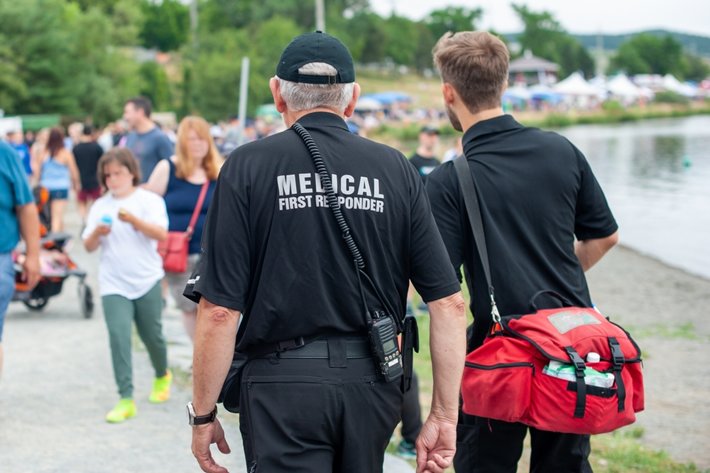The Extraordinary Dangers of Carfentanil

How could a drug intended to be used to subdue massive animals be killing Americans? It’s a long and tangled path for this ultra-powerful opioid from its origins to the point where it’s killing our friends and neighbors.
That path starts with a drug that was only ever approved for use by veterinarians who are treating large wildlife. It was never intended or approved for use with humans. If you’ve seen rhinos and elephants being sedated for medical care or transport, this is the drug that is used. Its effects are easily reversed with the antidote drug naloxone, the same drug used to reverse opioid overdoses on our streets.
It was also one of two drugs used to subdue terrorists who took hostages at the Dubrovka theatre in Russia in 2002. Chemical analysis of clothing worn during the attack revealed that the two chemicals that were pumped into the air of the theater to knock out the terrorists were carfentanil and a similar drug, remifentanil. The combination was so potent that 125 people died, including all of the terrorists and many of the hostages.
Carfentanil is 10,000 times more potent than morphine. One hundred times stronger than fentanyl. Just a few tiny grains of this drug constitute a fatal overdose for a human. Carfentanil is one of a family of chemically-similar drugs that include sufentanil, alfentanil and acetylfentanyl. At least 20 fentanyl analogs (similar drugs) have been found on the illicit market, and many more versions exist in labs.
Cheap, Popular, and Deadly
While it’s not to be used on humans, it’s so cheap that it’s become popular with illicit drug manufacturers and traffickers. That’s because it’s cheap. It’s one hundred percent lab-created. No plants are needed like with heroin, cocaine and cannabis.
And because it is so potent, a tiny amount goes a very long way, making it easier to traffic than a bulkier drug like heroin.
Someone, somewhere, had the idea to add carfentanil to America’s illicit drug supplies for the phenomenal profits that could be made. When it’s added to heroin supplies, it gives these products a more intense effect. But the potency of the drug in very tiny doses makes it challenging to mix it evenly into a pile of heroin or other powdered drugs.
Drug dealers still try to utilize carfentanil and other fentanyl analogs in their sales. That’s because less actual heroin needs to be added to any bag of drugs sold to a customer once a dash of fentanyl or carfentanil has been added. A drug dealer’s heroin supplies go further and he makes more money per bag sold.
Where is Carfentanil Being Manufactured?
This drug was originally created in 1974 by Janssen Pharmaceutica. At one microgram, it begins having an effect on humans. That’s one-millionth of a gram. As mentioned, it was originally reserved for large animal use, with the brand name Wildnil.
The carfentanil being added to illicit drug supplies is manufactured in foreign countries, with most of the labs thought to be in China. Then long-established smuggling routes are used to bring it through Mexico and into the U.S. It then gets distributed to most of the U.S. states.

An Infinitesimally Small Fatal Dose
For a human, a fatal dose of carfentanil is typically 20 micrograms (20 millionths of a gram.) A person who habitually consumes opioids might have built up a tolerance and be able to survive a slightly higher dosage.
In 2016, a package of carfentanil weighing more than two pounds was intercepted in Canada. That’s enough for 907,184,666 fatal doses.
Carfentanil Spreads Across the U.S.
In 2015, the Drug Enforcement Administration (DEA) issued a health and safety warning about fentanyl appearing in America’s illicit drug supplies and followed it in 2016 with a warning about carfentanil. A 2018 report from the DEA noted that carfentanil was the most common of the dozens of fentanyl-type drugs found in Florida. It was assumed that this drug was being surreptitiously added to cocaine supplies as 84 Floridians died with both cocaine and carfentanil in their bodies. It has also been found in heroin and methamphetamine supplies, and in counterfeit pills mimicking prescription painkillers or other medications.
In a year’s time, 1,236 people died with carfentanil in their bodies. The greatest number of seizures of carfentanil occurred in Ohio, Florida, Pennsylvania, Kentucky and Michigan.
In 2018, carfentanil supplies began to drop. Two researchers correlated this drop in carfentanil supplies with a small decrease in overall overdose deaths in 2018. This decrease only lasted until February 2019 when our losses began to climb once again.
The effects of carfentanil and other opioids can be reversed by immediately administering the antidotal drug naloxone. Much higher doses of naloxone are needed for drugs like fentanyl and carfentanil than for heroin or morphine. One instruction from the DEA says to administer a dose of naloxone every two to three minutes until the person is breathing on their own or emergency medical personnel arrive. If naloxone is not administered repeatedly, the person can lapse back into a fatal overdose, even if they initiate breathing for a while after the first few doses.
Carfentanil is Still With Us
The supply of this drug may have dropped somewhat but the deadly drug is definitely still with us. In 2019, when any of the fentanyl analogs were seized by federal authorities, it turned out to be carfentanil 27.5% of the time.
As further evidence of its continued presence in our drug supplies as recently as 2021, two residents of Riverside County, California were arrested that year for possession of an unbelievable 46 pounds of carfentanil.
It may be difficult to grasp the idea that some people are willing to put others at risk by trafficking and distributing this immensely powerful drug. As long as it is happening, however, the only safety exists in avoiding the use of all illicit drugs. For this reason, any person who is addicted to any prescription or illicit drugs should be convinced to enter a drug rehabilitation program as soon as possible.
Sources:
- European Centre on Drugs and Drug Addiction. “Fentanyl drug profile.” EMCDDA, undated. EMCDDA.
- PubMed. “Analysis of clothing and urine from Moscow theatre siege casualties reveals carfentanil and remifentanil use.” PubMed, 2012. PubMed.
- Science. “Underground labs in China are devising potent new opiates faster than authorities can respond.” Science, 2017. Science.
- Drug Enforcement Administration. “DEA Issues Carfentanil Warning To Police And Public.” DEA, 2016. DEA.
- Drug Enforcement Administration. “Deadly Contaminated Cocaine Widespread in Florida.” DEA, 2018. DEA.
- Centers for Disease Control and Prevention. “Overdose Deaths with Carfentanil and Other Fentanyl Analogs Detected—10 States, July 2016–June 2017.” CDC, 2018. CDC.
- National Library of Medicine. “Carfentanil and the Rise and Fall of Overdose Deaths in the United States.” NLM, 2020. NLM.
- United States Sentencing Commission. “Fentanyl and Fentanyl Analogues.” USSC, 2021. USSC.
- USA Today. “Synthetic opioid strong enough to ‘kill more than 50M people’ seized in California, authorities say.” USA Today, 2021. USA Today.


 ®
®